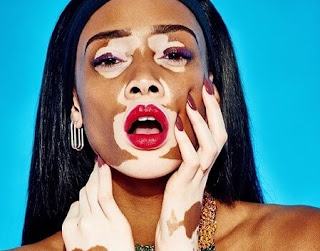What do you know about Vitiligo?
The person in these pictures is Winnie Harlow, a Canadian model and activist. She gained popularity as one of the contestants in the 21st edition of TV series, America’s Next Top Model. The prominent form of her skin condition, vitiligo, made her a stand-out participant. So, what do you know about vitiligo?
What is Vitiligo? Vitiligo is a rare condition of the skin where pale and white patches develop on it due to lack of enough melanocytes that produce melanin. Vitiligo is caused by insufficient pigment melanin in the skin integument. Melanocytes are skin cells that are responsible for giving the skin its colour; black, white, brown, plum, etc.
Vitiligo is capable of affecting different areas of the skin. It commonly appears on the face (around the mouth, eyes), neck, hands (including the fingers and wrists), armpits, pubic region, and the skin creases – most especially the palmar.
People that live with vitiligo are vulnerable to severe sunburns because of the thin dermis of their skin, so it is necessary to avoid excessive sunlight. Insufficient melanin in these areas affected by vitiligo can make the hair colour turn to grey or white.
However, one common characteristic of vitiligo is that it does not cause dryness and discomfort, but the patches may sometimes get scratchy.
Vitiligo is not the same from person to person; some have patches wider and not evenly distributed, others may have smaller and thinner white patches that connect over large parts of the skin.
Some events that initiate vitiligo are skin damages such as severe sunburn or cut, and stress during childbirth. Another common vitiligo initiator is chemicals. Those who work in factories, laboratories, and sites where they are exposed to chemicals risk getting this skin condition. However, it is not transmittable as an infection from person to person.
Sometimes, when vitiligo was diagnosed in persons, it was traced to their family history. It could be due to autoimmune conditions in the family.



Comments